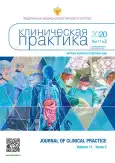Surgical treatment of the knee joint contractures after total knee arthoplasty
- Authors: Akhpashev A.A.1, Brizhan L.K.2, Artemiev A.A.1, Bolotnikov M.A.3, Shipulin A.A.4, Kashoob A.M.4
-
Affiliations:
- Academy of Postgraduate Education under the FSBU “Federal Scientific and Clinical Center for Specialized Medical Assistance and Medical Technologies of the Federal Medical Biological Agency”
- Acad. N.N. Burdenko Main Military Clinical Hospital
- National Medical and Surgical Center named after N.I. Pirogov
- Peoples Friendship University of Russia, Medical Institute
- Issue: Vol 11, No 3 (2020)
- Pages: 35-42
- Section: Original Study Articles
- URL: https://journals.rcsi.science/clinpractice/article/view/34078
- DOI: https://doi.org/10.17816/clinpract34078
- ID: 34078
Cite item
Full Text
Abstract
Background. The development of contractures after total knee replacement is most often associated with arthrofibrosis and constitutes up to 1.3–5.7% of the total number of cases of joint replacement. The conservative treatment is ineffective. Arthrolysis is pathogenetically substantiated (arthroscopic or open).
Aim: assessment of the effectiveness of arthrolysis as a method of treating knee joint contractures after arthroplasty, comparison of the results of arthroscopic and open arthrolysis, analysis of complications.
Methods. We compared two groups in a retrospective study. In group 1, 57 patients underwent arthroscopic arthrolysis. In group 2, 54 patients underwent open arthrolysis. The operations were performed from 2015 to 2019, the observation period ranged from one year to three years. As criteria for the result of the treatment, the KSS data were used (general and functional assessment of the knee joint), as well as, separately, the amplitude of movements in the joint before surgery and at different times after it.
Results. One of the results of this work was the optimization of arthroscopic arthrolysis technique. The surgical access and the joint revision sequence were improved. According to the KSS scale and range of motion, the best results were obtained in group 1. Especially important is the lesser number of complications in comparison with the 2nd group requiring repeated interventions, including revision arthroplasty. In the 1st group, we observed 3 such cases (5.3%) , in the 2nd group — 7 (13.0%).
Conclusions. Arthroscopic arthrolysis is a less traumatic and more effective treatment for arthritis of the knee. It seems appropriate to gradually replace open arthrolysis by the arthroscopic approach.
Full Text
##article.viewOnOriginalSite##About the authors
Alexander A. Akhpashev
Academy of Postgraduate Education under the FSBU “Federal Scientific and Clinical Center for Specialized Medical Assistance and Medical Technologies of the Federal Medical Biological Agency”
Email: akhpashev@gmail.com
SPIN-code: 9965-1828
MD, PhD
Russian Federation, MoscowLeonid K. Brizhan
Acad. N.N. Burdenko Main Military Clinical Hospital
Email: brizhan.leonid@mail.ru
SPIN-code: 8909-0116
MD, PhD, Professor
Russian Federation, MoscowAleksander A. Artemiev
Academy of Postgraduate Education under the FSBU “Federal Scientific and Clinical Center for Specialized Medical Assistance and Medical Technologies of the Federal Medical Biological Agency”
Email: alex_artemiev@mail.ru
SPIN-code: 3124-2701
MD, Professor
Russian Federation, MoscowMikhail A. Bolotnikov
National Medical and Surgical Center named after N.I. Pirogov
Author for correspondence.
Email: dr.bolotnikov@gmail.com
aspirant
Russian Federation, MoscowAleksander A. Shipulin
Peoples Friendship University of Russia, Medical Institute
Email: mp-747@yandex.ru
SPIN-code: 4383-1350
aspirant
Russian Federation, MoscowAli M. Kashoob
Peoples Friendship University of Russia, Medical Institute
Email: dr.ali.kashoob@gmail.com
ORCID iD: 0000-0002-4999-585X
aspirant
Russian Federation, MoscowReferences
- Kim J, Nelson CH, Lotke PA. Stiffness after total knee arthroplasty: prevalence of complication and outcome of revision. J Bone Joint Surg. 2004;86(7):1479–1484.
- Yercan HS, Sugun TS, Bussiere C, et al. Stiffness after total knee arthroplasty: prevalence, management and outcomes. Knee. 2006;13(2):111–117. doi: 10.1016/j.knee.2005.10.001.
- Gandhi R, de Beer J, Leone J, et al. Predictive risk factors for stiff knees in total knee arthroplasty. J Arthroplasty. 2006;21(1):46–52. doi: 10.1016/j.arth.2005.06.004.
- Возницкая О.Э., Сабирьянов А.Р., Атманский И.А. Восстановительное лечение при эндопротезировании коленного сустава: учебное пособие. — Челябинск: Челябинская государственная медицинская академия, 2009. — 82 с. [Voznickaya OE, Sabiryanov AR, Atmanskiy EA. Vosstanovitelnoe lechenie pri endoprotezirovanii kolennogo sustava: uchebnoe posobie. Chelyabinsk: Chelyabenskaya gosudarstvennaya medicinskaya akademiya; 2009. 82 р. (In Russ).]
- Миронов С.П., Котельников Г.П. Ортопедия: национальное руководство. 2-е изд., перераб. и доп. — М.: ГЭОТАР-Медиа, 2013. — 944 с. [Mironov SP, Kotelnikov GP. Ortopediya: natsional’noe rukovodstvo. 2nd revised and updated. Moscow: GEOTAR-Media; 2013. 944 р. (In Russ).]
- Hutchinson JR, Parish EN, Cross MJ. Results of open arthrolysis for the treatment of stiffness after total knee replacement. J Bone Joint Surg Br. 2005;87(10):1357–1360. doi: 10.1302/0301-620X.87B10.16228.
- Jerosch J, Aldawoudy AM. Arthroscopic treatment of patients with moderate arthrofibrosis after total knee replacement. Knee Surg Sports Traumatol Arthrosc. 2007;15(1):71–77. doi: 10.1007/s00167-006-0099-5.
- Babis GC, Trousdale RT, Pagnano M, et. al. Poor outcomes of isolated tibial insert exchange and arthrolysis for the management of stiffness following total knee arthroplasty. J Bone Joint Surg. 2001;83(10):1534–1536. doi: 10.2106/00004623-200110000-00012.
- Enad JG. Arthroscopic lysis of adhesions for the stiff total knee arthroplasty. Arthrosc Tech. 2014;3(5):611–614. doi: 10.1016/j.eats.2014.07.001.
- Manrique J, Gomez MM, Parvizi J. Stiffness after total knee arthroplasty. J Knee Surg. 2015;28(2):119–126. doi: 10.1055/s-0034-1396079.
- Panni AS, Cerciello S, Vasso M, Tartarone M. Stiffness in total knee arthroplasty. J Orthop Traumatol. 2009;10(3):111–118. doi: 10.1007/s10195-009-0054-6.
- Donaldson JR, Tudor F, Gollish J. Revision surgery for the stiff total knee arthroplasty. Bone Joint J. 2016;98-B(5):622–627. doi: 10.1302/0301-620X.98B5.35969.
Supplementary files












